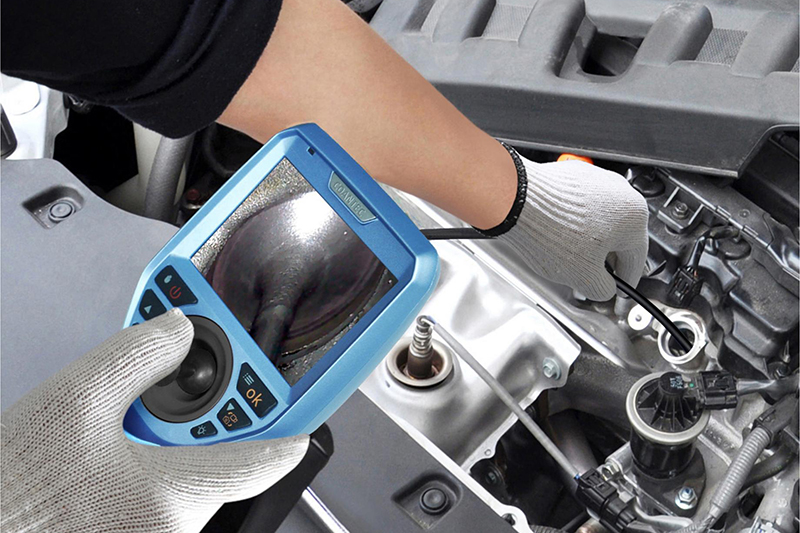Loading
Whether in automotive production or repair, automotive Borescopes are crucial inspection tools. There are numerous brands and models of industrial Borescopes on the market, and choosing one is a complex task, considering numerous parameters and specific usage scenarios. So, how can you choose the right automotive Borescope for your needs?

Coantec ME+ Series Automotive Borescope
You can consider the following aspects:
I. Clarify your core needs (this is the most important first step).
1. Frequency of use and level of expertise?
Ordinary car owners/DIY enthusiasts: Occasional use, checking for carbon deposits and finding dropped items. They are price-sensitive and seek ease of use.
Car enthusiasts/experienced DIYers: Frequent use, enjoy in-depth analysis of the engine and transmission, and have high expectations for performance and functionality.
Professional repair technicians: Daily use, with high requirements for clarity, durability, and efficiency. They have a relatively ample budget.
2. What areas are primarily inspected?
Engine cylinder/piston top: An ultra-thin diameter (≤6mm), high-definition, side-view lens (essential) is required to observe the cylinder wall.
Intake and exhaust valves and fuel injectors: A suitable length (over 1m) and good guidance are required.
Fuel tanks and oil pans: Waterproofing (IP67 or higher) may be required.
Air conditioning evaporator: A thin, rigid cable is required to navigate narrow air ducts.
Locking dropped objects (such as screws): The lens requirements are not high, but accessories such as magnets or hooks may be required.
II. Detailed Explanation of Key Performance Parameters
1. Camera (the core of the core)
Diameter:
4-6mm: Most commonly used, capable of accessing most areas such as spark plug holes and fuel injector holes.
<4mm: Ultra-thin, capable of accessing narrower spaces, but may sacrifice image quality and lighting brightness.
>8mm: Thicker, typically used for large inspections such as pipelines, and rarely used on vehicles.
Resolution/Pixels:
Standard Definition (<1 megapixel): Generally adequate, but details are blurred, not recommended. High-definition (1-2 megapixels): Currently the mainstream choice, it offers a high cost-effectiveness and meets most needs. Ultra-high-definition (2 megapixels and above): Delicate image quality allows for clear observation of details such as carbon deposits and wear, making it suitable for professional users.
Lens Orientation:
Forward View: The camera is positioned directly forward, looking straight ahead.
Side View (90 degrees): Highly recommended! This is crucial for inspecting cylinder walls, piston rings, and other components. Many products offer adjustable front and side views, making this the best option.
Illumination: LED lighting is typically used. Some fiber optic industrial Borescopes use optical adapters to transmit light through optical fiber. Portable or desktop light sources are acceptable.
Adjustable Brightness: This is crucial! Lowering the brightness in bright environments can reduce glare, while increasing the brightness in front of dark objects allows for clearer detail. Typical automotive Borescopes have a 0-7 level dimming range.
2. Cable
Length:
1 meter: Suitable for inspecting upper engine areas, such as the valve cover.
3-5 meters: A universal length, allowing access to lower engine areas, fuel tanks, and other areas. >5 meters: Required for specialized applications, rarely used in vehicles.
Material and Hardness:
Semi-rigid cable: Bends and retains its shape, making it easy to position inside the vehicle and preventing it from falling due to its own weight.
Flexible cable: Easy to operate, but cannot be fixed in position. Can navigate complex spaces and reach certain areas.
3. Display and Power Supply
Display Type:
Standalone handheld screen: Highly integrated, ready to use, and high brightness, suitable for outdoor and professional environments. This is the mainstream choice. Size (3.5-7 inches), Resolution (at least 480p), Brightness (for outdoor visibility)
Mobile/Tablet App Connection: Connect via Wi-Fi or USB. Advantages include a large screen and convenient recording and screenshot capabilities, but require a charged phone, can be unstable, and can make the screen difficult to read in strong outdoor sunlight.
Power Supply:
Lithium battery: Convenient, but battery life should be considered (typically 2-4 hours).
Type-C/USB power supply: Can be connected to a power bank for extended operation. 4. Functions and Accessories
Video recording and photography: Essential features for easy recording and comparison.
Accessories:
Magnetic probe or foreign object clip: Very useful for catching small metal parts (such as screws) that have fallen off.
Waterproof rating: If inspecting fuel tanks, water tanks, etc., IP67 or higher is required.
Also, if you don't want to wait for the vehicle to cool before inspecting, you can choose a high-temperature-resistant automotive Borescope.
Summary and Purchasing Steps
1. Understand the purpose: Determine your primary purpose before determining the appropriate functions and specifications.
2. Consider your budget: Explore the price range of automotive Borescopes with the same functions from different brands to understand the price differences.
3. Understand after-sales service: Automotive Borescopes are not disposable and may require subsequent hardware or software upgrades. Therefore, good after-sales service is crucial.